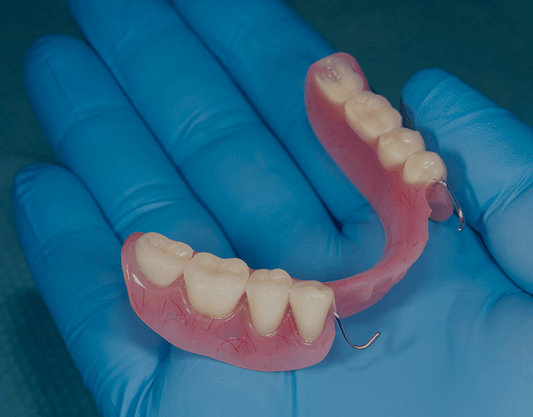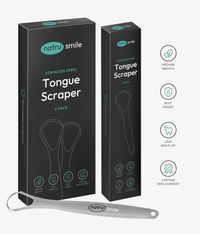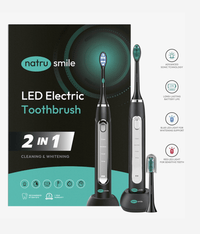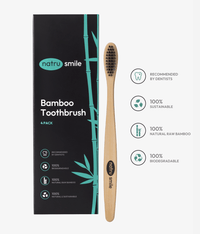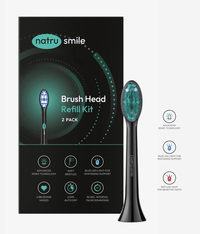
All products are certified by dental expert Dr. Greg Grillo
Missing a tooth? It might be a good idea to get a removable dental bridge. As missing teeth can lead to feelings of insecurity, 57% of Americans cover their mouths when they laugh for fear of having an unattractive smile.
Dental bridges are a popular way to replace missing teeth and improve your smile. While it can be permanently fixed, a removable dental bridge is ideal for those who don’t want the commitment of a permanent bridge. This type of bridge can be removed for cleaning or other repairs, making them more convenient than traditional bridges.
In this comprehensive guide, we will discuss what to expect when getting a removable dental bridge, including the costs and how to take care of it so that it will last for several years to come. Let's get started.
What Is A Removable Dental Bridge: A Quick Look
A removable dental bridge, also known as a partial denture, is a prosthetic device used to replace missing teeth. It consists of one or more false (artificial) teeth attached to an acrylic base that fits over the gums and is secured with metal clasps.
Removable dental bridges are typically made from a combination of materials such as porcelain or plastic resin for the artificial teeth and acrylic for the gum-fitting portion of the appliance.
Bridges may be connected to the base by metal clasps, or they may be welded together. The appliance is designed to fit comfortably and securely over the gums, allowing wearers to eat and speak normally.
In a bridge vs implant comparison, bridges are attached to the teeth surrounding your missing tooth, while implants are artificial tooth roots typically composed of titanium screwed into your jawbone to support a bridge or crown.
As a result of the way both are placed and the materials used, implants are more expensive than bridges, but they do have the advantage of having a higher success rate and lasting for a longer period of time.
You might also be tossing up dental crowns vs tooth bridges. Note that a crown is typically used when teeth have been shattered or chipped; a bridge, on the other hand, is used to replace entire teeth.
Essentially, a removable dental bridge offers an affordable, easy solution to replacing lost teeth without having to undergo extensive dental work.
What's The Difference Between Removable And Fixed Bridges?
When it comes to replacing missing teeth, dentists have several options available. Two of the most common solutions are removable and fixed bridges.
Knowing the difference between these two types of bridges is important when deciding which one is best for your dental needs.
A removable bridge consists of false teeth (or tooth) that rest on a gum-colored plastic base and are held in place with metal clasps or precision attachments onto adjacent healthy teeth. The entire bridge can be easily taken out by either the patient or their dentist.
While a removable bridge for one tooth tends to be more common, it can also be used to replace multiple teeth in a row. Removable bridges are typically less expensive than fixed bridges but require extra care and maintenance from the patient.
A fixed bridge, also known as a traditional dental bridge or a fixed partial denture, is not removable and has crowns that are permanently affixed to the teeth adjacent to the gap in your mouth through a dental abutment.
Abutments are usually produced in a dental laboratory and are commonly composed of titanium, stainless steel, zirconia, gold, or polyether ether ketone.
Since fixed bridges require a more complex procedure, they are also generally more expensive.
A fixed bridge known as a cantilever dental bridge is also often preferred because it only requires affecting one adjacent tooth and disrupts less of the natural tooth surface. Cantilever bridges are also reversible, look very natural, and are commonly used in the front of the mouth, where they blend almost invisibly with surrounding teeth.
When deciding between removable and fixed bridges, it’s worthwhile to consider how many missing teeth need to be replaced, your budget, and any other factors that may influence your decision. A qualified dentist can help you decide which type of bridge is best for you based on your individual needs.
What To Expect From Removable Dental Bridges
Removable dental bridges require less time in the dentist's chair compared to their permanent counterparts. They usually only require two visits to the dentist, each lasting between an hour and an hour and a half. The process of putting in and removing these devices is generally easier and faster than with permanent options.
Your dentist may initially suggest that you wear your removable dental bridge continuously so they can note any areas of discomfort and adjust them when needed. It might feel awkward or uncomfortable at first, but with the necessary changes and as time passes, you'll become more accustomed to it and even experience better eating and speaking abilities.
An advantage of getting a removable dental bridge is that you will be able to remove it for cleaning or when going to bed. With a bit of practice, you will soon become more confident about removing and reinstalling the device.
Patients can expect removable dental bridges to last anywhere from five to seven years, depending on the material of the bridge and how well it’s cared for.
With proper care, it is even possible that a bridge could last around a decade or so.
Cost Of Removable Dental Bridge
The cost of removable dental bridges varies greatly depending on the type of bridge chosen and the complexity of your individual case. In general, removable dental bridges are one of the more budget-friendly solutions, with costs that range from $300 to $2,500.
In addition to the cost of materials and labor, there are other factors that may also impact the total price tag, such as laboratory fees and additional medical appointments needed prior to fitting.
Before choosing a removable dental bridge, it’s worthwhile to discuss all of your options with your dentist and understand the cost associated with each option.
How To Clean A Removable Bridge
Removable bridges are an excellent way to replace missing teeth and restore your smile. Just like natural teeth, removable bridges need regular cleaning and maintenance to keep them in top condition.
Here is a quick guide on how to clean a removable bridge properly so that you can enjoy the benefits of dental restoration without worry or hassle.
- Start by getting everything you’ll need: soft-bristled toothbrush, toothpaste, lukewarm water, mouthwash (optional), and floss (optional). Place all these items near your sink for easy access while you are cleaning your bridge.
- Begin by rinsing your bridge with cool water: This will help to remove any food particles that may be stuck on the surface of the bridge.
- Use super floss: As it is not possible to floss between the tooth units in a bridge with regular dental floss, it would be better to use specialized tools, such as a super floss, interdental brush, or floss threader, to clean under the bridge.
- Use a soft-bristled toothbrush: Gently scrub your bridge in circular motions with gentle toothpaste, making sure to reach all surfaces of the teeth and gums.
- Thoroughly rinse the bridge to remove all toothpaste and debris from the bridge.
It is advised not to keep your removable bridge submerged in water or a denture-cleaning solution for extended periods of time unless advised to do so by your dentist. The metal parts of the bridge could corrode if left in liquid for too long.
Removable Dental Bridge (Photos)
Maybe a removable dental bridge will work for you to improve your smile. Here are removable dental bridge samples that will give you a better understanding of how these prosthetics look in the mouth.
Caring For Your Removable Dental Bridge
Caring for a removable dental bridge requires regular maintenance and consistent effort to ensure its longevity. The following tips will help you maintain your dental device.
Rinse It When Removed
Even though wearing your dental bridge feels good and allows you to chew properly, it is wise not to wear them constantly. Taking them out of your mouth occasionally will give the gums and bones supporting them a break, as well as allow for proper cleaning.
When you remove your removable dental bridge, you should rinse the bridge off with cool water and gently scrub away any food particles or plaque that may have accumulated during use.
Brush Your Dental Bridge
Brushing your removable dental bridge helps remove plaque, food debris, and bacteria that can lead to cavities, gum disease, and other health concerns.
Start by brushing the abutment teeth using gentle circular motions, then use a specialty floss threader or special interdental brushes to clean around the base of each abutment tooth where it meets the pontic (the artificial replacement tooth).
Focus on cleaning between the gums and the pontic, as this is where food debris and bacteria can accumulate.
Use A Soft-Bristled Toothbrush
Using a soft-bristled toothbrush is an effective way to take care of your teeth.
Soft bristles are gentle on the enamel of your teeth while still being able to effectively remove plaque and bacteria that can cause cavities or bad breath.
Temporary dental bridges are also best cleaned with soft bristles in order to prevent damage to the device.
Brushing your teeth too hard with stiff bristles can cause damage to the enamel, which serves as a protective layer for your teeth. This damage cannot be reversed and can create an environment in which more bacteria can stick to your teeth, leading to decay.
How Do You Eat With A Removable Bridge?
When you initially receive your removable bridge, it is suggested that you eat more tender foods cut into small pieces. When eating, make sure to evenly distribute the food on both sides of your mouth and stay away from hard, chewy, and sticky foods.
It may take some time to get used to eating with a removable bridge, but practice makes perfect. Your dentist will be able to guide you on how best to adjust the fit of the bridge and how to keep it clean.
Can You Chew With A Removable Bridge?
Eating with a removable bridge is much like eating with dentures. To properly insert and remove the bridge, you need to use your hands to gently push it into place or remove it from your mouth. You should also make sure that the bridge fits securely so that when you eat, food does not get stuck between teeth and gums.
How Long Does A Removable Bridge Last?
Generally lasting between 5-7 years, temporary dental bridges can last for up to a decade if they are taken care of properly. Good oral hygiene habits and regular visits to the dentist will help extend the life of your bridge.
Conclusion
Getting a removable dental bridge can be an affordable way to restore your smile. The process of installing a removable dental bridge is relatively simple and painless, so you can save yourself time and money by avoiding more expensive treatments like implants or bridges that are not as easily removed.
With the right oral hygiene habits in place - such as regular brushing, flossing, and rinsing - your removable dental bridge can serve as an aesthetically pleasing addition to your smile and restore your confidence for years to come.

